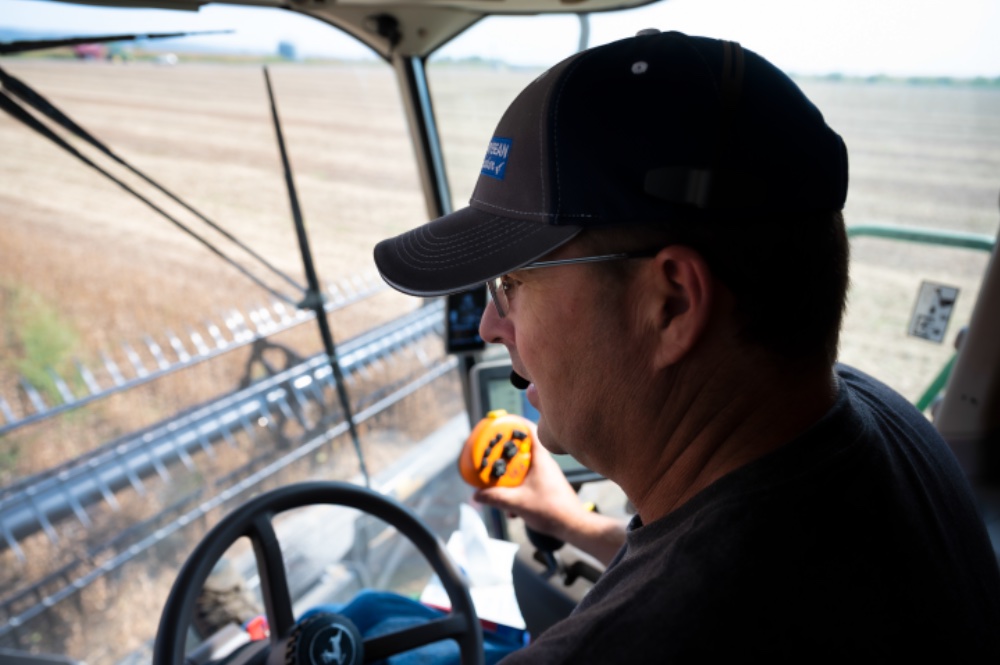
Jeff Jorgenson, ISA president, is encouraged by indicators pushing demand internationally. He said the soybeans grown by U.S farmers offer a high-quality trustworthy product for international buyers. (Photo: Joseph L. Murphy/Iowa Soybean Association)
Cargill executive sheds light on markets, sustainability efforts
January 7, 2021 | Bethany Baratta
Soybean prices are strengthening as China continues its buying and dry weather in South America potentially limits soybean supplies globally.
In a virtual event hosted by the U.S. Soybean Export Council (USSEC), Cargill’s head of corporate trading and executive vice president for the agricultural supply chain Joe Stone said prices could go higher yet as markets continue in ”rationing” mode.
“If the function of the market today is to continue to ration, then we’re going to probably have to go a little bit higher than where we are today,” Stone said. “But that could be a very, very choppy ride depending on the weather we have in Argentina.”
If Argentina starts getting precipitation, the soybean market could be nearing the highs. If dry conditions persist, markets could go higher still, he says.
Soybean prices closed at $13.65 per bushel on Jan. 6, a level not seen since June 2014.
Global demand
Global soybean demand has grown 250% since 1990, says Jim Sutter, CEO of USSEC. He wonders if the recent price rally puts global demand for U.S. soy at risk.
Helping boost prices for soybeans is demand from China, which is rebuilding its hog inventory after African swine fever decimated the herd. He expects demand to also strengthen as customers resume normal dining habits put on hold during Covid-19.
“Customers in China that are consuming the meal that we produce are definitely in expansion mode and that’s really good for soy demand longer term,” Stone said.
Soy reserves have dwindled in the past 5 years, and the country is looking to the United States to rebuild their stocks. This bodes well for soybeans, Stone said.
“Chinese demand is real, and I think it’s a positive for our grain markets over the course of the next 12 to 24 months,” he said.
Expanding opportunities to sell soybeans globally is at the heart of U.S. Soy’s mission. Increased demand for U.S. soy underscores the importance of maintaining the soybean industry’s presence around the world through USSEC, said Iowa Soybean Association (ISA) President Jeff Jorgenson of Sidney.
“We could be nine months away from harvesting a record-sized crop, but that record crop needs demand to be able to move it,” Jorgenson said. “We rely on USSEC as our boots on the ground to be able to do that.”
Hearing Stone say there were no major hiccups in delivering U.S. soybean products to global customers despite the global pandemic reaffirmed the strength of the supply chain, Jorgenson said.
“If there’s demand, we have to be able to supply it,” Jorgenson said. “Even through COVID we are efficiently getting grains moved to port and around the world with strength in demand. It’s nice to know we’re still able to do that.”
Ag part of the solution
Sutter says global consumers ask questions about where their food or ingredients come from, yet the flow of commodities doesn’t confirm that these characteristics play a major role in their purchasing decisions. So how will the sustainability factor play into the future?
“I think sustainability and climate change are the issues of our time and we believe that ag is part of the solution,” Stone said. “There’s a tremendous amount that we can do in ag to help mitigate and fight climate change.” He noted that Cargill supports 750 farmers in 12 programs (including The Outcomes Fund of which Iowa Soybean Association is a partner) to target soil health practices that help mitigate green gas emissions and impacts of climate change.
Capturing incentives for ultimately improving soil health is appealing, says Suzanne Shirbroun, an ISA director near Farmersburg.
“I hear so much about carbon credits and sustainability, but I have a lot of questions,” Shirbroun said. “As the next generation comes on board on our farm, I’m going to have to do more research to see how it can fit on our farm.”
Morey Hill said Stone’s comments pairing sustainability and climate change were thought-provoking.
“As a producer, I’m used to thinking of sustainability as doing more with less, so to speak,” Hill said. “But maybe as a policy organization ISA needs to keep that thought in mind. I think ISA can be a catalyst and involved in leading that conversation.” Go here to listen to the conversation between Jim Sutter and Joe Stone.
Back